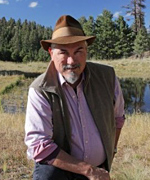Everyone is saying that 2019 will be a seminal year for water. They are really thinking mostly of the Colorado River situation, which largely sucks the air out of the room in discussions of water issues as a whole.
Where do we stand on Arizona’s implementation of the Lower Basin Drought Contingency Plan (LBDCP)? We’re close — but not quite done. Supposedly, a framework was agreed upon in December that consisted of mitigation for farmers plus offsets to the major sources of mitigation water. Water would have been provided to Pinal County irrigation districts to mitigate the sudden loss of the CAP ag pool in a Tier 1 shortage; likewise, money would have been given to the tribal groups putting up the water. Plus, money was also promised for new wells in Pinal County to transfer irrigation agriculture back to reliance on groundwater. Although water would have been moved out of Lake Mead to cover Pinal’s ag needs for the short-term, this CAP Intentionally Created Surplus (ICS) would have been offset by new tribal ICS. Arizona has no true appreciation of how much it owes to the tribes that stepped up to redirect water in a time of need.
All of this is being done so that the Legislature will pass a resolution authorizing ADWR to sign on to the LBDCP with the other states. Pinal County agricultural interests carry weight with the legislators, so their support is necessary. Standing at the gateway of the Legislature is the new Speaker of the House, Rusty Bowers, who is the acknowledged water expert amongst legislators as well as the supreme strategist of legislative actions. His support is essential. Speaker Bowers is connected to Arizona’s ranching and farming roots and will protect Pinal County agriculture. He has attended every LBDCP Steering Committee meeting since its inception, and he knows every nuance.
In December, the Bureau of Reclamation declared a deadline of January 31 for action by Arizona to approve the LBDCP. Commissioner Brenda Burman stated that, if no action is forthcoming by that date, Reclamation will request recommendations from all the Basin states and act to protect the Colorado River. The other states are displeased with Arizona’s delays. It is almost guaranteed that the Federal solution will be more draconian than the cuts envisaged for Arizona under the LBDCP.
Speaker Bowers is not a fan of Federal pressure. He has stated that water issues are too complex to be rushed through, that discussion is needed. One implication could be that the door is open to further requests by ag interests for more water and money. Apparently, the development community is also now asking for a 3-year supply of water for CAGRD, in addition, to a deal with the Gila River Indian Community (GRIC) that would have covered any shortfall. That deal had been seen as the answer to developers’ concerns that CAGRD would get no water after excess water disappears in Tier 1. Developers also have influence in the Legislature. We are close but not done and, once in the Legislature, we could be a little less done than we were in December.
Other legislative requests are also part of the framework. Salt River Project needs to see a “skinny repeal” of aspects of the definition of water eligible for recharge (WaterBUD) to allow an exchange to move water to Pinal County. GRIC needs to see the LBDCP signed prior to creating tribal ICS on Lake Mead. The Colorado River Indian Communities need to know that money is secured to compensate them for leaving water on the River. Cities need to see changes in how long-term storage credits will be handled by the Water Bank prior to signing contracts to send their CAP water to Pinal County storage facilities. Everyone has their needs, and now all eyes are looking towards the Legislature and Speaker Bowers.
Lake Powell water level elevations have dropped considerably, a major concern to Upper Basin states. As of 1/5/2019, water levels are at 3580.87 feet above MSL. At 3575 feet, the mid-elevation release tier, Lake Powell releases to Lake Mead could be reduced to 7.48M acre-feet. This could kick Arizona into a Tier 2 shortage by 2021. All Pinal County mitigation ends then. Lake Powell inflows in 2018 were the lowest in decades, and it remains to be seen how much snowpack will accumulate in 2019. However, predictions for a mild El Niño event in 2019 provide a modicum of hope, despite a fairly dry December. But it likely won’t be enough to delay a shortage declaration in 2020.
People have qualms about the whole process. The implementation framework still envisions taking up to 400,000 acre-feet of CAP ICS off Lake Mead. Even though creation of tribal ICS would offset this diversion, it is still an accounting gimmick at its core. A “run on the bank” in which all parties attempt to retrieve their ICS before Federal action removes that possibility is a potential scenario. California has already announced it will begin taking its ICS off the Lake beginning in January. Also, the mitigation for agriculture envisions new wells. These wells will outlast the mitigation period by decades, and increasing groundwater withdrawals will lead to depleted aquifers. Once launched on this slippery slope, other entities will join in, to the detriment of the goals of the Groundwater Management Act. That’s hard to swallow.
Yes, 2019 will be a seminal year. Eyes will be fixed on the Legislature, on the snowpack in the Upper Basin, on water level elevations on two giant lakes, and on the DCP process in general. And the air in the room will remain depleted.
